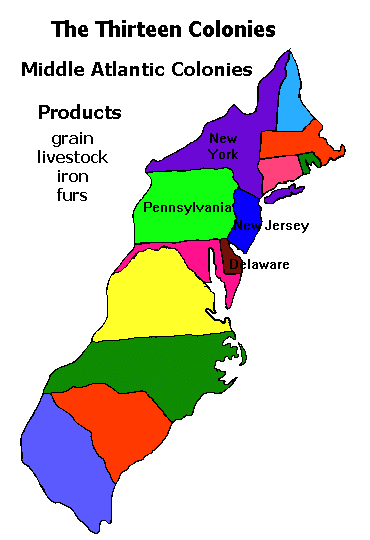Friday, February 22, 2008
Facts for Pennsylvania
Originally settled by Dutch and Swedes. Came under English control in the 1664 and was granted to William Penn by Charles II in 1681. The Dutch lay claim to Pennsylvania in 1609. Since water was sometimes impure, all members of the family drank milk and whiskey. Compared to New England, the soil was much more fertile and less rocky. This influence included tolerance in religion, and resulted in New Netherland's success as the commercial center of the eastern North American colonies. There were many brick buildings in the Middle Colony due to the amount of clay along the riverbanks. The Middle Colonies had a plentiful supply of fish, oysters and lobsters. In the woods, boar was the game of choice. Wild turkeys roamed everywhere and were ripe for the picking.Flax produced linen and deerskin was used to make breeches, shirts, jackets, and moccasins.
Tao: The Middle Colonies Climate
The Middle Colonies had really nice climate. It was hotter than New England but cooler than the Southern Colonies. Since of its relevantly hot whether, it had longer growing seasons. That means the grew more crops. And in the cold winters they had fertile soil. In New England it is more rocky.
Pennsylvania
Pennsylvania and Delaware owed their initial success to William Penn.
Under his guidance, Pennsylvania functioned smoothly and grew rapidly. By 1685 its population was almost 9,000.
Though the Quakers dominated in Philadelphia, elsewhere in Pennsylvania others were well represented. Germans became the colony's most skillful farmers. Important, too, were cottage industries such as weaving, shoemaking, cabinetmaking and other crafts.
Thursday, February 21, 2008
Adams and Tyler's History of our state
New Jersey is a state in the Mid-Atlantic and Northeastern regions of the United States. It is bordered on the north by New York, on the east by the Atlantic Ocean, on the southwest by Delaware, and on the west by Pennsylvania. Parts of New Jersey lie within the sprawling metropolitan areas of New York and Philadelphia.
Inhabited by Native Americans for more than 2,800 years, the first European settlements in the area were established by the Swedes and Dutch in the early 1600s.[3] The State's name was taken from the largest of the English Channel Islands, Jersey. The English later seized control of the region, which was granted to Sir George Carteret and John Berkeley, 1st Baron Berkeley of Stratton as the colony of New Jersey. New Jersey was an important site during the American Revolutionary War; several decisive battles were fought there. The winter quarters of the revolutionary army were established twice by George Washington in Morristown, which was called the military capital of revolution. Later, working-class cities such as Paterson and Trenton helped to drive the Industrial Revolution in the nineteenth century. New Jersey's position at the center of the BosWash megalopolis, between Boston, New York City, Philadelphia, Baltimore and Washington, D.C., fueled its rapid growth through the suburban boom of the 1950s and beyond. As of 2008, New Jersey had more millionaire residents than any other state in the nation.
Inhabited by Native Americans for more than 2,800 years, the first European settlements in the area were established by the Swedes and Dutch in the early 1600s.[3] The State's name was taken from the largest of the English Channel Islands, Jersey. The English later seized control of the region, which was granted to Sir George Carteret and John Berkeley, 1st Baron Berkeley of Stratton as the colony of New Jersey. New Jersey was an important site during the American Revolutionary War; several decisive battles were fought there. The winter quarters of the revolutionary army were established twice by George Washington in Morristown, which was called the military capital of revolution. Later, working-class cities such as Paterson and Trenton helped to drive the Industrial Revolution in the nineteenth century. New Jersey's position at the center of the BosWash megalopolis, between Boston, New York City, Philadelphia, Baltimore and Washington, D.C., fueled its rapid growth through the suburban boom of the 1950s and beyond. As of 2008, New Jersey had more millionaire residents than any other state in the nation.
Subscribe to:
Comments (Atom)
